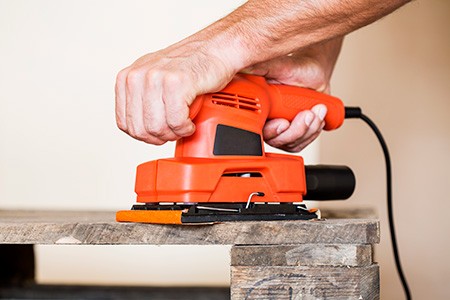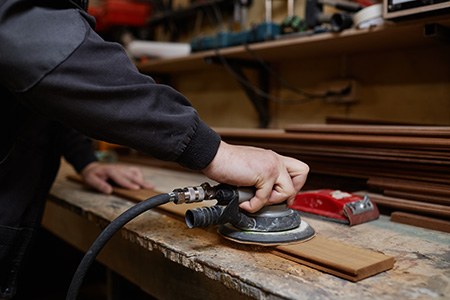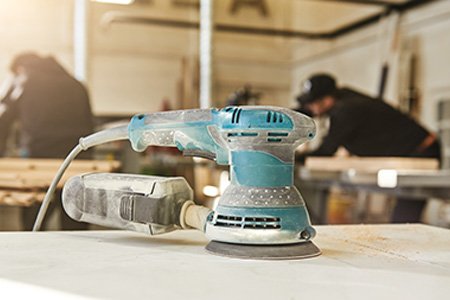Wet Sanding vs. Dry Sanding: When to Choose Each
Author: Omar Alonso | Editor: Omar Alonso
Review & Research: Jen Worst & Chris Miller

Choosing the right sanding method for your next project can be daunting - should you go wet or dry? When it comes to wet sanding vs. dry sanding, one crucial factor is that wet sanding excels in achieving a glass-like finish, while dry sanding is ace at shaping and leveling surfaces.
This post will provide detailed insights into each technique: their applications, results, speed, mess, safety hazards, and pros and cons.
Differences Between Wet Sanding & Dry Sanding

Wet sanding and dry sanding differ in their application, results, speed, mess, and safety.
What is wet sanding? It involves using water or a lubricant to reduce friction and dust while achieving a smoother finish.
Dry sanding is more efficient for shaping and leveling surfaces but generates more dust.
Application
When to wet sand and dry sand can vary significantly according to the project's needs. One primarily uses wet sanding for achieving a smooth finish, commonly on painted wood surfaces or during automotive refinishing.
The process involves water and an abrasive like high grit sandpaper to polish out flaws, often in straight lines and alternating directions. On the other hand, dry sanding is used extensively in shaping and leveling surfaces such as metal or drywall, requiring no lubricants but lower grit papers.
Removing scratches efficiently while working in small circles for a balanced finish is crucial. Both methods play significant roles across several industries, especially automotive manufacturing.
Results
The results from wet sand vs. dry sand techniques differ significantly, primarily due to the distinct processes involved. Wet sanding yields a smoother and shinier finish, perfect for aesthetic purposes like automotive paint jobs or refinishing furniture.
This happens because it uses water as lubrication, reducing grit scratches that can march the surface's appearance. Notably, this technique is essential in paint correction for automotive applications, ensuring flawless output.
On the contrary, dry sanding removes more material efficiently—an ideal approach for shaping and leveling surfaces swiftly in woodworking or drywall projects. However, it requires expert handling to avoid unwanted swirl marks on the final product – a testament of its higher task demands but impressive transformative capabilities.
Speed
In the wet sanding vs. dry sanding battle, which is faster? In terms of speed, dry sanding takes the lead over its wet counterpart. This method quickly removes material from surfaces, making shaping and leveling tasks efficient - a real-time-saver in woodworking or drywall projects, even more so when using the right grit sandpaper for drywall.
However, despite being more time-consuming, wet sanding holds its ground with a slower yet meticulous approach. The process involves employing water as a lubricant to gradually smooth out imperfections on automotive finishes or wood surfaсes without causing further harm.
So while you might save time during dry sanding, opting for wet sand gives you precision and refinement worth every extra minute spent.
Mess

Sanding can get messy, but your chosen method can affect how much cleanup you must do. Wet sanding tends to be less messy compared to dry sanding. When wet sanding, the water acts as a lubricant and helps trap dust particles, preventing them from becoming airborne.
This means less dust will settle on surrounding surfaces and in your workspace. On the other hand, dry sanding produces more dust because there is no moisture to keep it contained.
Wear protective gear like goggles and masks when dry sanding to avoid inhaling or getting dust in your eyes.
Safety
Safety is a crucial consideration when it comes to both wet sanding and dry sanding. Dust particles produced during the sanding process can be harmful if inhaled, posing risks to respiratory health.
Both techniques require proper safety measures, such as wearing goggles and dust masks, to protect against these hazards. Wet sanding, however, offers some advantages in terms of safety compared to dry sanding.
It generates less dust due to the use of lubricants like water or oil, reducing the risk of airborne particles. This makes wet sanding a safer option for both professionals and DIY enthusiasts looking to minimize exposure to potentially harmful substances while achieving excellent results.
Advantages & Disadvantages of Wet Sanding

Below are the merits and demerits of wet sanding vs. dry sanding;
Better Dust Reduction for Wood Surfaces
What does wet sanding do? It is an excellent technique for better dust reduction when working on wood surfaces. Unlike dry sanding, which creates clouds of fine dust particles that can settle and spread everywhere, wet sanding minimizes the mess.
The water used as a lubricant during wet sanding helps lock the dust particles, preventing them from becoming airborne and making cleanup much easier. This is particularly beneficial for indoor jobs or areas where you want to avoid breathing in excessive dust.
Supports Paint Correction for Automotive Applications
Wet sanding is a technique that provides valuable support for paint correction in automotive applications. This method helps fix flaws or imperfections in an uneven paint job, ensuring a perfect finish.
By applying water and using specialized wet and dry sandpaper, the process gently removes layers of paint without causing damage to the delicate surfaces of vehicles. Moreover, wet sanding can be more forgiving, as the water acts as a lubricant that prevents deep scratches or further harm to the surface.
Its ability to correct mistakes and achieve flawless results makes wet sanding an essential technique in the automotive refinishing industry.
Longer Process Time

Wet sanding, although yielding a smoother finish, has one drawback: it takes longer to complete than dry sanding. This is because wet sanding involves using water or a lubricant, which slows the process slightly.
However, this additional time investment can produce exceptional results, especially when working on delicate surfaces like painted wood or automotive bodies. The longer process time allows for more precision and attention to detail, resulting in a professional-level finish worth the wait.
Smoother Finish
Wet sanding delivers a remarkably smooth finish, making it the go-to technique for achieving flawlessly polished surfaces. By using water as a lubricant during the sanding process, wet sanding minimizes friction and reduces the likelihood of scratches or imperfections.
The water helps keep the abrasive particles from clogging up and cools down the sanded surface, preventing damage caused by excessive heat buildup. As a result, wet sanding leaves behind an exceptionally even and glossy surface that showcases impeccable craftsmanship.
Dry sanding can also contribute to achieving a smooth finish but may require additional steps for optimal results. While dry sanding might remove material more aggressively than wet sanding, it can potentially leave finer scratches on the surface if not executed with precision and care.
Nevertheless, when combined with subsequent polishing or buffing processes, dry sanding can still yield impressive results in creating smooth surfaces on materials such as wood or metal.
Advantages & Disadvantages of Dry Sanding

Want to learn about the pros and cons of dry sanding? Keep reading! Wet sanding vs. dry sanding isn't a complicated subject, but there is a lot to consider.
Removes More Material
Dry sanding removes larger amounts of material quickly, making it ideal for shaping and leveling surfaces. This technique effectively smoothes out rough areas and achieves a more even finish.
The abrasive nature of dry sanding allows it to easily strip away imperfections, saving time and effort. While it may produce more dust compared to wet sanding, its ability to remove more material efficiently makes it a go-to choice for projects that require significant material removal.
Whether working on woodwork or tackling a DIY project, dry sanding can help you achieve the desired result effectively.
Quick & Efficient for Shaping & Leveling
Dry sanding offers quick and efficient results when shaping and leveling surfaces. This method removes material efficiently, making it ideal for initially smoothing rough surfaces.
Whether working on wood or preparing a surface for painting, dry sanding gets the job done effectively. It's advantageous when you quickly shape or level large areas.
The aggressive nature of dry sanding allows it to remove material rapidly, making it perfect for those who prioritize speed without compromising quality.
More Dust Formation
Dry sanding has the disadvantage of creating more dust compared to wet sanding. This can result in a messy workspace and requires extra clean-up afterward. The dust produced during dry sanding can be harmful if inhaled or get into your eyes, so wearing protective gear such as goggles and masks is essential.
You can use a vacuum attachment with your sander or work in a well-ventilated area to minimize dust formation. Despite this drawback, dry sanding is still preferred for its ability to remove more material and efficiently shape and level surfaces when done correctly.
Requires Proper Technique to Avoid Swirl Marks
Proper technique is essential when it comes to dry sanding to avoid those pesky swirl marks. Swirl marks are circular microscopic scratches that can appear on car paint or other surfaces if not handled correctly.
Using the correct sandpaper grit and applying even pressure while sanding is essential to prevent them. Taking the time and using smooth, consistent strokes will help you achieve a flawless finish without unwanted blemishes.
Remember, practicing good technique will ensure your hard work pays off with a beautifully smooth surface free from unsightly swirl marks.
That’s the Wet Sanding vs. Dry Sanding Overview
Wet sanding and dry sanding have advantages and disadvantages depending on the application. Wet sanding is ideal for achieving a smooth finish and is commonly used in automotive refinishing.
It reduces dust effectively, making it popular among interior painters. On the other hand, dry sanding removes material quickly and efficiently, making it perfect for shaping and leveling surfaces.
However, dry sanding produces more dust and requires proper technique to avoid swirl marks. Choosing between wet and dry sanding depends on the project requirements and desired results. That's your overview on wet sanding vs. dry sanding and when to choose which application.



